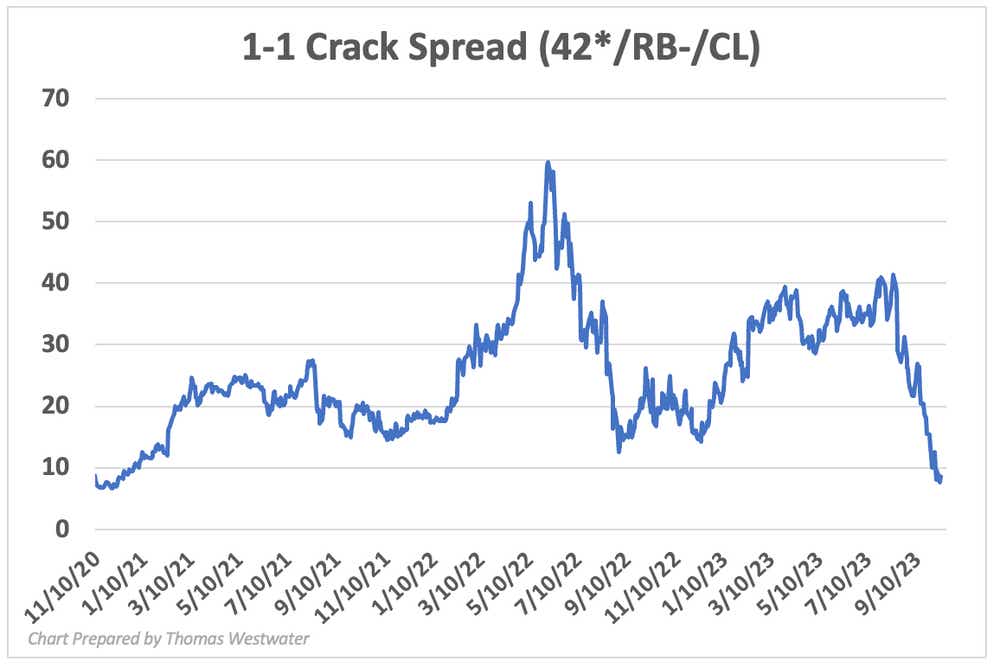Trading the Crack Spread in a Shifting Oil Market

Trading the Crack Spread in a Shifting Oil Market
EIA Data in focus for oil and fuel futures
- A key oil crack spreads spotlight trading opportunity.
- Geopolitical risks may widen the 1-1 spread.
- Fuel inventories are in focus as traders assess supply.
Crude oil prices (/CLX3) fell nearly 10% last week, the biggest weekly percentage drop since March. That decline was fueled by a stark drop in gasoline demand, as outlined by inventory data published by the U.S. Energy Information Administration (EIA).
Those figures showed that finished motor gasoline supplied, a de facto measure for demand, dropped to 8 million barrels per day (bpd). That marked nearly the lowest level since January. Although this time of the year typically sees seasonal weakness in fuel demand, the market saw it as a sign of demand destruction from high pump prices.
Is demand destruction the true cause?
While the market took the EIA’s numbers at face value, some analysts were skeptical that the data reflected the true on-the-ground picture. The EIA’s numbers aren’t technically at fault here, but instead the market’s interpretation of its data.
The EIA doesn’t account for fuel demand past the wholesale market. So, what could be happening here? The drop in oil prices and seasonal trend expectations could have caused gas station operators to destock—a phenomenon in which stations reduce on-hand inventory to hedge themselves against short-term price drops.
Once oil prices stabilize or reverse higher, those station owners restock their inventory to align with real demand. If this is indeed what is playing out across markets, we should see it in this week or next week’s data from the EIA. If so, it could cause gasoline futures (/RB) and heating oil futures (/HO) to rise quickly as traders can price in the new data.
What is the trade?
One way to play this assumption is to get long those fuel products, of course. However, we can also trade the crack spread—which is the pricing difference between a barrel of crude oil and the petroleum products refined from crude. Recently, the 1-1 crack spread between crude oil and gasoline has fallen to multi-year lows (see chart below).
If the EIA data due later this week shows a rebound in gasoline demand, those crack spreads would be likely to widen, and the move could be substantial given the relative movement seen over the past few weeks. A play on the widening crack spread would be implemented by going long a fuel product, either gasoline (/RB) or heating oil (/HO), while also shorting crude oil (/CL).
However, if we are bullish on both crude oil and fuel products, you can remain synthetically long the crack spread by overweighting your long position on /RB or /HO relative to your long /CL trade. A widening crack spread is also bullish for refiners since it represents the theoretical refining margin, so a long trade on XOP or CRAK or even XLE would make sense too.

Thomas Westwater, a tastylive financial writer and analyst, has eight years of markets and trading experience. @fxwestwater
For live daily programming, market news and commentary, visit tastylive or the YouTube channels tastylive (for options traders), and tastyliveTrending for stocks, futures, forex & macro.
Trade with a better broker, open a tastytrade account today. tastylive, Inc. and tastytrade, Inc. are separate but affiliated companies.
Options involve risk and are not suitable for all investors. Please read Characteristics and Risks of Standardized Options before deciding to invest in options.